Ahoy, squirts! Quint here with the first major piece in this weeklong celebration of one of my all time favorite movies: Indiana Jones and the Temple of Doom.
Producer Frank Marshall has been a major factor in most of the movies you love from the '70s and '80s. He was a cornerstone of Steven Spielberg's Amblin Entertainment and helped usher to the screen pretty much every Amblin and Spielberg film starting with Raiders of the Lost Ark.
He and his wife Kathy Kennedy run Kennedy/Marshall Productions... Kathy is a little bit busy nowadays in Star Wars land, but Frank's still hard at work producing films both attached to Spielberg's legacy (Jurassic World) and new potential franchises (Assassin's Creed).
When I started putting feelers out for this series Frank was the first major player to respond and has been a big cheerleader for me, which I very much appreciate. He not only set aside an hour for us to discuss his involvement in Temple of Doom at his Santa Monica office, he also sent a ton of personal photos from his and Kathy's collection.
You'll see them below. Some will be included in the interview, and the rest will be featured below with a little commentary.
In the below interview we talk about Frank's second unit directing, Harrison Ford's injury, tales from location scouting, the film's dark tone and the subsequent controversy upon release. We also go on a few tangents into Last Crusade, ET and Back to the Future territory. I hope you guys enjoy the chat.
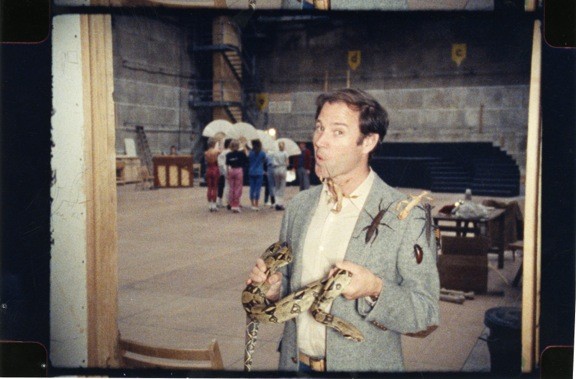
Quint: Thank you so much for taking the time to talk to me about Temple of Doom.
Frank Marshall: Sure, I'm happy to do it.
Quint: I'm a massive, massive Temple of Doom fan. I really love that movie.
Frank Marshall: Wow, okay!
Quint: I mean, I can objectively look at Raiders and say that's a perfect film from top to bottom. I can say that Raiders is the best Indiana Jones movie, but I think Temple of Doom might be my favorite. It's easy to say kids in particular love Temple of Doom because they have an entry point with Short Round. They feel like they're going on an adventure with Indiana Jones because of that character, but looking back on it I think I was also responding to the fact that you guys weren't trying to remake Raiders.
Frank Marshall: Right.
Quint: You weren't trying to capture that exact lightning in a bottle again and that's why I've grown to love the movie even more as I've grown older. Every possible creative choice pulls in a different direction than Raiders.
Frank Marshall: A lot of that came from us all agreeing on the first movie that we were going to do three movies. I had never done that before. George had done it before. I think the fact that you know you're going to make 2 and 3, that enables you to be thinking about it while you're making 1.
They were inspired by the serials and the idea we'd start the movie with a serial episode that's just ending, you don't know what happened, but you're meeting new characters... that was the coolest part for me. We didn't do that on Back to the Future. Back to the Future was a one-off. And Gremlins. I think Back to the Future 2 and 3 worked, but (Indiana Jones) was different because we had this motif in place. We had this plane going across the map and he's an adventurer.
Quint: Do you remember why you guys decided to make Temple of Doom a prequel?
Frank Marshall: I don't know why. That was more George and Steven. I was fine with “Give me the script and I'll tell you how to make it.” I'm trying to think... why did we go earlier? We didn't want to get into the war. It was something about that.
Quint: I love what that does for Indy as a character. The third film kind of ret-cons it a little bit, but Indy's arc in Temple of Doom is that he's becoming the Indiana Jones of Raiders. He is a darker character.
Frank Marshall: He's a rogue, yeah.
Quint: By doing a prequel you're also forced into a MacGuffin that isn't so amazing that it doesn't make sense why the Ark of the Covenant blows Indy's world up a little bit in that first movie.
Frank Marshall: I remember reading about the Sankara Stones and wondering what they are! What do these things look like? We were trying to figure this out.
Quint: My understanding, from talking with Steven, is that George very much set the tone of the movie. It seems to me that mirrors Empire Strikes Back a little bit. It's the darker second movie.
Frank Marshall: Exactly.
Quint: At what point did you come into the process? I'd imagine before the script came in because you were already talking about a sequel during Raiders.
Frank Marshall: We were talking, but back in those days I was much more what we today call the line producer as opposed to being in on the development of the script. It was enough with the two of them (George and Steven). We had a great team in London, the same team that did Star Wars and Raiders, headed by Robert Watts who was sort of my co-producer/co-conspirator whatever you want to call it.
We knew we were going to shoot in London again, at Elstree, because everything was about stability and loyalty and using all the same people. It was a great time in the '80s. We knew we were going to do this, we thought, in India, so I started the process of working with the Indian government. We did a location scout with Steven in India and we saw these great palaces, but the government wanted to read the script.
We gave them the portions of the script that took place in India and they rejected us because we were calling someone a Maharajah, which I guess is not the correct thing. First of all, really? All the economic benefit you're going to have and this (is what's stopping you)?
The scout was valuable because we were in India. We saw real palaces and people. The next best thing was Sri Lanka. All this stuff sounds crazy today when you think about it. “Aw, let's just go to Sri Lanka! Why not?” We set up this trip to scout Sri Lanka. We all went and stayed in the capital. Arthur C. Clarke was there, so we all got to meet Arthur C. Clarke! I guess George had communicated with him during Star Wars. That was cool. Bonus! Going to dinner at Arthur C. Clarke's house. Kind of amazing.
Anyway, we flew up to this little town called Kandy because the production designer and location manager said this is a great place to be and we can do all the stuff there. We were looking for a place to build the rope bridge. Amazingly enough they were building this big dam about 20 minutes away from Kandy. There was this span just north of the dam that you could put a rope bridge across. The dam was being built by a British company, Balfour Beatty was their name. The Brits said they'd help up, so suddenly there's all the technology and materials to build our rope bridge and what better way than to have real people designing it and engineering it.
If you're looking this way up the canyon you see the rope bridge and if you turn around there's this giant construction project going over here. We said to Steven, “Can you not look that way?” He said, “Absolutely.” That's the great thing about Steven. There are some directors that would say, “I don't think so, I need to be able to see that way” because they don't know. Steven knows what he needs and what he wants.
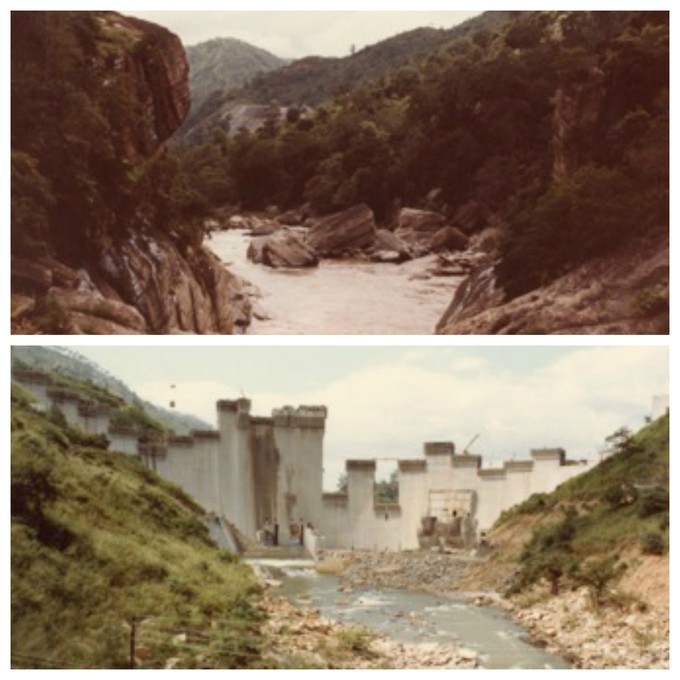
So, we built this rope bridge. I gotta say, the first time I was out on it, it's like 350 feet up and I'm saying “Who built this? Are we sure we want to go out there?” It was hairy being out on that bridge.
Quint: I know that Steven notoriously wouldn't go all the way out to the middle of it.
Frank Marshall: No. And the stedicam operator. He wouldn't go out on it. There are a couple of shots where we follow Harrison out onto the bridge and he would only go (so far). I think we had a second unit guy who came in and put on the gear and shot it.
Quint: Did Harrison's stunt double, Vic Armstrong, do most of that?
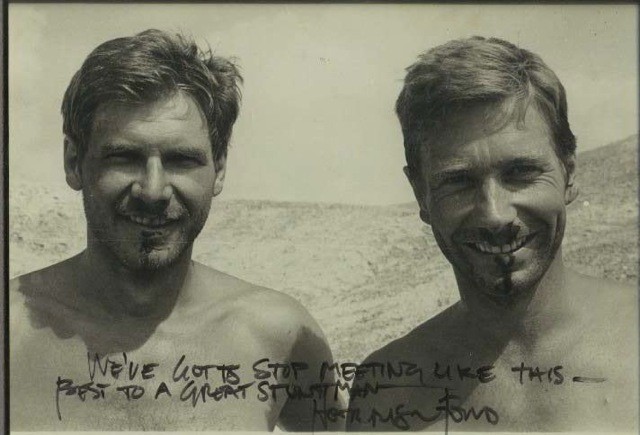
Frank Marshall: Well, Harrison had no problem. Of course Harrison had to be the macho guy and do it, but I remember the first time Kathy (Kennedy) and I walked across it one side had the cable, but it wasn't filled in. It was really freaky. Even though you were holding on there was nothing over here. It was a real rope bridge with steel cables wrapped in twine and rope, which then, of course, gave us the challenge of breaking it. Those were the days where there was no take two. If all of those bolt cutters don't cut the cables at the same time... are we into an optical shot? I don't think so. That made that moment pretty exciting, when we cut the bridge. George Gibbs was the special effects guy who set that off.
Quint: I know that Temple of Doom had a rocky production. Harrison hurt his back and was out of shooting for a bit. I also read that Doug Slocombe, the DP, got hurt when a bulb exploded next to him.
Frank Marshall: I don't remember that, but probably. But the Harrison one was major because he had to go away for 6 weeks. Steven then also did something I don't think anybody else could have done, which was to keep shooting with Vic. We would save the reverses that were on Harrison.
Quint: What happened with Harrison, exactly? He slipped a disc or something?
Frank Marshall: Yeah. I think he'd had it for a long time and the elephant ride enflamed it. Then he went back and had the apricot treatment or something... you know, where they put apricot juice on it or something. Everyone thought, “This is not good,” but it worked! He came back and we did all the close ups.
We shut down for a week, which was covered by insurance, and then Steven said “I want to keep going.” We shot all these sequences, it was amazing.
Quint: Now these sequences you guys shot were in the mine, right? On the conveyor belt?
Frank Marshall: Yeah, on the conveyor belt and in the mine car. It was a huge sequence. The other blessing we had was Vic was such a good double.
Quint: Yeah, he looked so much like Harrison around that time.
Frank Marshall: From the back he was completely the same body type and mimicked Harrison in a great way.
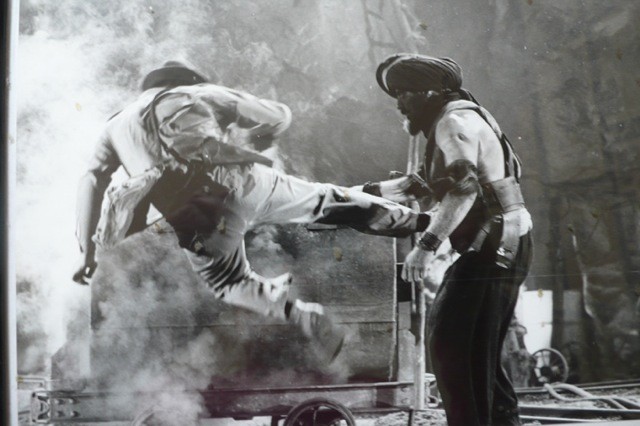
Quint: The highest compliment I can give is that before I heard all those stories I had no idea you guys had to cheat so much for those scenes.
Frank Marshall: It's seamless.
Quint: Raiders was notoriously a kind of challenge that Steven imposed on himself to get a movie done quickly and cheaply.
Frank Marshall: On that budget... I remember Michael Eisner (then CEO of Paramount Pictures) called George when he read that script and heard what we thought we could make it for, which was $20 million. He said, “You're going to spend $20 million on that opening sequence!” with the jungle and boulder and all the action that we had. It was a challenge that Steven rose to.
Quint: That energy on Raiders is palpable and you can tell that same vigor went into Temple of Doom. The pacing of that film is unlike anything he's done before or since. Once you go into the bug tunnel the film just kind of rockets you to the end.
Frank Marshall: It's a freight train. Non-stop.
Quint: From your perspective, do you see that motion in the script and go, “How the hell are we going to pull this off?” or were you more cool and collected about it?
Frank Marshall: Those were the days when it was so exciting, the challenge of how do we do it. Like, the bit where they jump out of a plane on a life raft. Today somebody would be in a little room drawing it somewhere. We actually had to do it!
We were based up in San Anselmo, where Lucasfilm was in those days, and in the area where we would go to lunch most days there was a life raft manufacturer. So I went over there one day and said, “Here, I got a challenge for you. We need this life raft and we need it to inflate as it goes out of an airplane.” He looked at me like, “Have you lost your mind!?!” I said, “No, it's a movie.” “Oh, okay.”
They designed this life raft that when tossed out, the ripcord would pull something and it would inflate. Then we found the tri-motor (plane). We always felt the more real things we can use, the more fun and the better it's going to look. We found this tri-motor and it happened to be up there in the Bay Area. There was this guy who had a golf course and landed it on his golf course. We found this tri-motor and it was perfect. Steven loved it and George loved it.
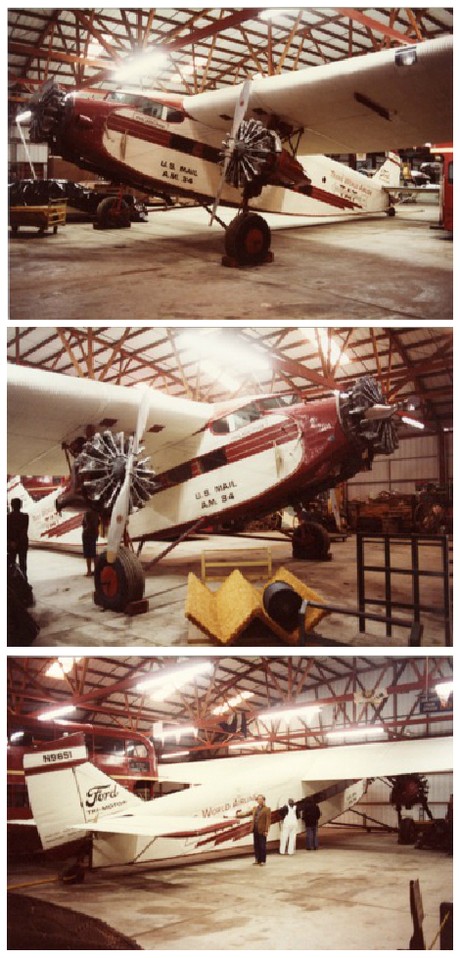
We took 2nd unit up to Mammoth Peak and set the cameras up. We had these three dolls that we'd made that we set up inside the raft. Now, this was all theory. This old tri-motor would fly, first of all, to Mammoth, which is high altitude. The pilot was the owner, this old guy.
So, we put a couple of stunt men in the plane to throw this thing out. This thing came out and I'm watching it and it perfectly balances, unfolds right side up, the people are in it, it comes down and hits and bounces and they're weighted enough where it looks real and then slides down. We all looked at each other and I was waiting for someone to say, “Ready when you are, C.B.” We didn't have monitors or playback or anything. I said, “I think we got it.” I looked at the three or four cameramen and they went (thumbs up). I said, “We're done!” The shot that's in the movie is the first take. One shot. Unbelievably exciting and cool.
Quint: What if you didn't get it that take?
Frank Marshall: We had another... we'd just do it again. We'd have to try it again.
Quint: What if it just never worked?
Frank Marshall: Then I guess we would have had to have gone with a visual effects shot. We'd just fly the plane over and then send it to ILM and say, “Put the raft in.”
So, we did that and then we went to Twin Falls, Idaho. That's where we threw the raft off the cliff. Then we went to the American River (in California) and we shot the raft in the rapids. So we did all real. It was like this little adventure unit.

Quint: It's funny. Critics of the movie always point to the life raft scene was being too unrealistic and I've always countered that with, “Maybe, but they really did it! That's a real shot!”
Frank Marshall: That's true. Granted, there weren't people in it, but it still landed, didn't deflate, and started tobogganing down the hill.
Quint: It is literally real! It could be a one in a thousand moment you guys captured, but it's not a trick shot.
Frank Marshall: That's the thing. Visual effects, which I think are great, are just a tool. I think some filmmakers today get lazy. In those days, like when we were shooting the skyline of Shanghai in Empire of the Sun, there was one modern building. It was a Holiday Inn or something. I went to shoot the coffins floating by with the skyline in the back. I put the camera here and went, “Oh, that building is in the shot.” So, then I had to figure out how to block the building, so I lowered the camera and I put a crate on the right. That actually made a better shot. Today, I would probably go “Just paint it out!” and the camera would be up here. Having to block it out made me more creative.
If you did that shot of them falling out of the plane with a CG raft... the thing about CG shots is you don't know what's missing because it's all put in. When the raft hits there's this snow that comes up in a realistic, obviously because it's real, way and you probably wouldn't have thought to put those little particles in. So something about it wouldn't look quite right.
When there's an explosion in CG you're going to forget something, which is why it's going to look fake. Unless you're putting it in, it's not going to be there. It's a great tool when used right, but I think you have to be careful with it.
Quint: You shot more than just the raft scene on Temple of Doom. You did all the second unit with the gators, right?
Frank Marshall: Oh, yeah. We went to Gatorland in Florida and had to figure out how to get these alligators to spin. We had these trainers there who threw raw chickens in. I remember this one time the chicken landed on an alligator's head and he's just lying around with this big, white hunk of meat on his head. We did those shots with another little guerrilla unit.
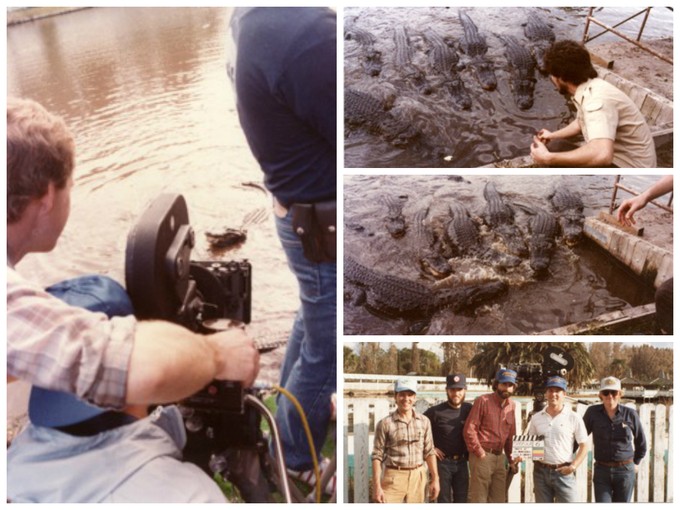
Quint: One of my absolute favorite shots in the movie is after a gator eats a thuggee and is violently rolling around in the water with the thuggee's clothes wrapping around its body. It's so violent and sparked some kind of primitive “get away” instinct in me when I first saw it.
Frank Marshall: That's how they kill their prey. It's called a death roll. We had thuggee dummies and we put chicken inside them and threw them in. Those are the days where we just kept rolling. Unfortunately we didn't have (digital) drives then, so we'd run out of film.
What was it? Which one of the Raiders did he have to go through spinning swords?
Quint: Sounds like Last Crusade when he's going through the tests at the end to get to the grail.
Frank Marshall: Yes! He's going for the chalice. It's the second unit's job to do these shots that take forever. He does 60 set ups and I do 2. We had the camera lined up and we had two guys who would let the swords go and a guy would go sploosh with the blood, right? Do you remember that?
Quint: Is that when the German is sent up and the blades cut off his head and it rolls down the steps?
Frank Marshall: Yes, it rolls down the steps. We would do it and we had real swords. They'd go and then the blood was late. Or the blood would be early. It was take after take. I'm watching, because again we don't have monitors. I'm standing next to this big magazine and I say, “Okay, roll.” “We're rolling.” I go, “Action!” It goes great. Just as the blood starts to go I hear (makes sound of the film running out of the camera). The magazine rolled out. We never got it again. It was perfect! We got one that's good enough. It's in the movie, but still the perfect one was gone.
Quint: Another aspect I adore about Temple of Doom are the sets.
Frank Marshall: Oh, great sets.
Quint: The temple of doom set itself, with the giant Kali statue, is one of my favorite sets ever filmed.
Frank Marshall: Elliot Scott at his finest.
Quint: Is there anything you recall about the process of constructing those sets? Any major challenges about realizing them?
Frank Marshall: Designing the pit and how the pit operated while still being safe. How are we going to show the lava? How are we going to light it? There's steam... It was an amazing effort. Again, when it's real and you're not adding steam (in post-production) it just feels real.
The stage was big enough to make it not feel like a set. One of the reasons we were in England was the craftsmen were so great. It had been passed down all these years to plasterers and riggers and construction people... they'd been doing it forever and they were the best. The set was spectacular.
Quint: The way Slocombe lit it, too...
Frank Marshall: Dougie never used a light meter.
Quint: I've heard that. He used the shadow of his thumb against his hand, right?
Frank Marshall: Yeah. He'd say “Put another single (filter) up there.” Everyone was at the top of their game with that movie. Through the '80s it was the A-Team.
Quint: You say that and the first name that pops into my head is John Williams. As iconic as all the first three Indy scores are, Temple of Doom still stands above the rest for me.
Frank Marshall: I think it gave him a chance to stretch a little and be a little darker than Raiders, which was pretty light.
Quint: Temple of Doom saw a lot of controversy upon release. Famously it led to the PG-13 rating, of course, but I've also read a lot of criticism on it from the time and it's really harsh. Harlan Ellison wrote that Steven was ruining childhood innocence for a whole generation of kids with this movie and Gremlins. As someone who was a kid when it came out I just have to laugh. The adults could moan all they wanted to, but every one of my friends thought a dude getting his heart ripped out was the coolest thing ever.
Frank Marshall: Wow. Yeah, it was really controversial. I remember as it went international I went around and took frames out of certain countries' prints. Some countries we had to remove the heart scene all together.
Quint: Really? It's an amazing effect and is very effective, I'll give them that, but come on, now.
Frank Marshall: That's George Gibbs. He knew how to do that.
Quint: Speaking of that sequence, there's one shot in there I've always been curious about. There's a medium shot of Mola Ram holding up the burning heart and flaming chunks are falling away while he laughs maniacally. There's something about it that feels extra creepy to me. It could just be Amrish Puri's enthusiastic performance, but Mola Ram always looked animatronic to me in that scene. Was that really him or did you guys build an animatronic because of the fire danger?
Frank Marshall: No, I think it's a fake arm or something. It's really him. I can't imagine we would have spent money to do just one shot like that. I think it's him. He was... (laughs) He was a lunatic! He reveled in it, as you can see! He was perfect in the role. No, there was something they did to his arm to protect it.
Quint: So Amrish Puri was a crazy guy?
Frank Marshall: Yeah.
Quint: Did he intimidate the other cast and crew or...
Frank Marshall: Well, he wasn't there a lot. He was in, like, 10 movies a year in India and he'd fly back and forth. We'd have him for a week and then he'd go away, so he kind of stayed to himself. He was a pretty popular actor in India at that time.
Quint: He's so good in that role, definitely an iconic bad guy.
Frank Marshall: He was like a demon. He was very real and very serious about it.
Quint: He really does cement the tone of the movie. Big, dark... Looking back on it, I think people at that time might have had more of a problem with the tone than anything specific in the film, even the heart-ripping scene.
Frank Marshall: The fact that we had Short Round in it takes the edge off. Kids identify with him and Indy is fighting pure evil. You're rooting for him. And he has to take care of this girl who is completely different than Marion, but still he protects her.
You know the famous story about how we found Short Round?
Quint: I know you tested a lot of kids for it...
Frank Marshall: It was an open call. Kathy and I had gone to Chinatown here in LA and the casting people were bringing in kids to read. Ke brought his brother in to test. He was ordering him and saying “Do this” and “do this” and Kathy and I were kind of looking at him and going, “Who are you?” “Oh, I'm his brother. I'm kind of in charge.” We said, “Tell us about yourself.” He was from Vietnam and his dad was in jail and all this stuff. “Why don't you read for us?”
He put himself on tape and long story short he was the real Short Round. He was a very adult kid that was mature way beyond his years. Steven is so good at recognizing these kids who are not acting. He got (the role) because it was him. The same with Drew (Barrymore) and Henry (Thomas). These kids don't know how to be somebody else yet, but they're the right kid.
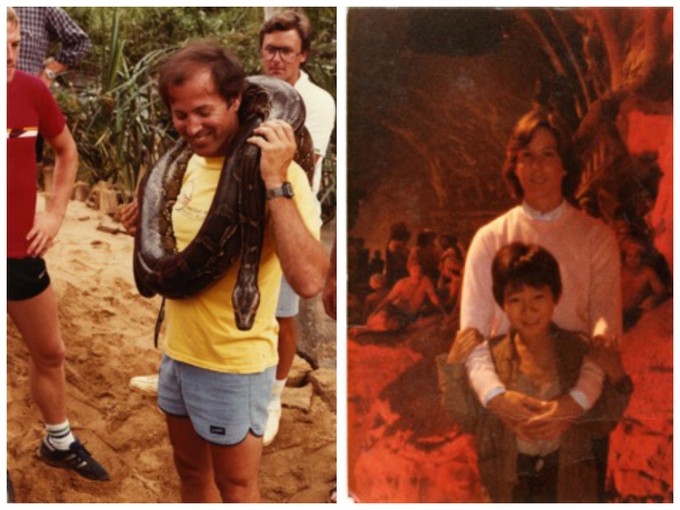
Quint: That whole era is filled with magic for me. Call it nostalgia if you want, but it felt like something special was going in big budget filmmaking at that period.
Frank Marshall: Everybody was at the top of their game then. Look at Robert Zemeckis and Bob Gale! The Back to the Future script... I tell screenwriting students just go read that script. It's a perfect set up and payoff script. Those were the days.
Quint: I'm sure people tell you this all the time, but you guys very much formed a generation with the films you made.
Frank Marshall: I think it was the right time and the right place. We just all happened to come together. It's all about the mixture. I was there in the '70s when Peter Bogdanovich and William Friedkin and Francis Coppola all were in a thing called The Director's Company, but they weren't doing it together. It was meant to be sort of the new United Artists, but they did things separately. There wasn't the synergy that we had in the '80s where everybody came together at Amblin. That's where everybody wanted to work and there was one guy who was in charge and that was Steven, who was managing all this. That was the difference.
Quint: Looking around at the photos you have up here, you guys look like you were having just as much fun making them as I did watching them when I was growing up.
Frank Marshall: That's a small regret that I have. I don't get to see the movies like you do, but I get to make them and my pleasure comes from moments like that first ET screening in Houston and the place erupted into a standing ovation. Sid Sheinberg was looking around like (mouth hanging open). We couldn't get theaters. The next day we had triple the bookings. The next day word had spread from that manager through the country.
Quint: Thanks very much for your time, man. I appreciate it.
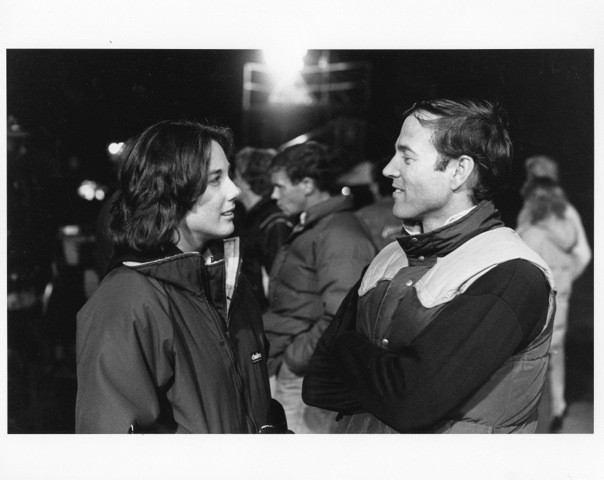
That's it for the interview, but let's look at some more photos. Most of these came from Frank directly, but the one from the second unit in the river comes courtesy of Lucasfilm.
Let's start with a grouping of some Sri Lanka scouting photos. How about the one with the real life snake charmer? How sweet is that?!?

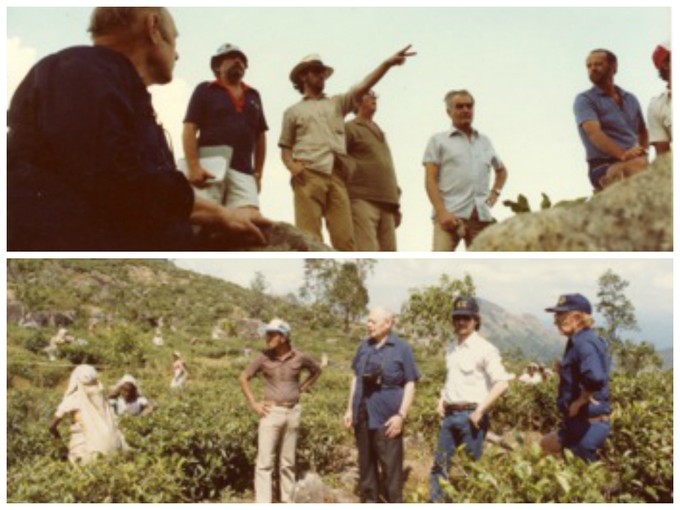
Yeah, that's Spielberg on the scout above. Neat. If you look closely, you can also catch the Beard beginning to imagine some bridge shots in the below grouping:
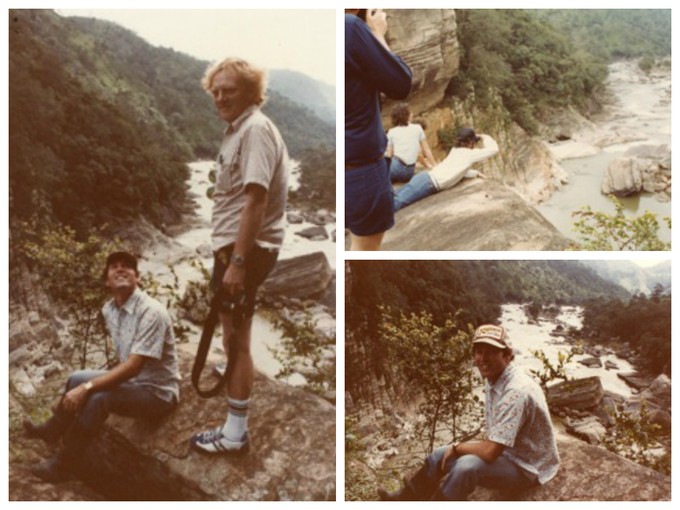


Next up is Frank Marshall's alter ego, Dr. Fantasy, performing a trick with Short Round himself, Jonathan Ke Quan, at the Temple of Doom wrap party!
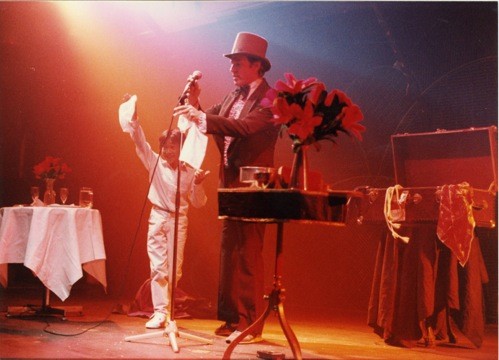
Finally, this picture is from the Royal Premiere of Temple of Doom and features Marshall meeting Princess Diana. This image captures what Marshall calls “my most personal cherished moment.” You can see fellow producers Robert Watts and George Lucas to his right.
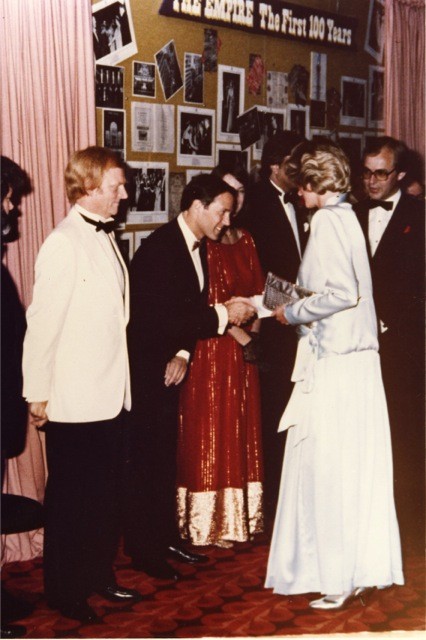
Thank you very much, Mr. Marshall, for all the cool pics and great conversation. And thank you guys for indulging my near obsessive adoration of this fine, fine movie. Stay tuned for many more rare insights into the making of the movie, guest essays, BTS pics and other fun stuffs rolling out this week.
-Eric Vespe
”Quint”
quint@aintitcool.com
Follow Me On Twitter

